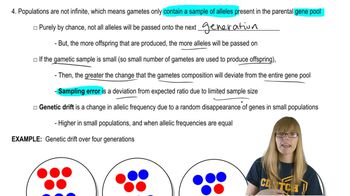Table of contents
- 1. Introduction to Genetics51m
- 2. Mendel's Laws of Inheritance3h 37m
- 3. Extensions to Mendelian Inheritance2h 41m
- 4. Genetic Mapping and Linkage2h 28m
- 5. Genetics of Bacteria and Viruses1h 21m
- 6. Chromosomal Variation1h 48m
- 7. DNA and Chromosome Structure56m
- 8. DNA Replication1h 10m
- 9. Mitosis and Meiosis1h 34m
- 10. Transcription1h 0m
- 11. Translation58m
- 12. Gene Regulation in Prokaryotes1h 19m
- 13. Gene Regulation in Eukaryotes44m
- 14. Genetic Control of Development44m
- 15. Genomes and Genomics1h 50m
- 16. Transposable Elements47m
- 17. Mutation, Repair, and Recombination1h 6m
- 18. Molecular Genetic Tools19m
- 19. Cancer Genetics29m
- 20. Quantitative Genetics1h 26m
- 21. Population Genetics50m
- 22. Evolutionary Genetics29m
21. Population Genetics
Allelic Frequency Changes
Problem 40d
Textbook Question
Divide the contents of a large bag of different-colored candies randomly and approximately equally among the members of the group. Do not pick specific candy colors, but simply empty the contents of the bag onto a table and quickly divide the pile. If you are doing this exercise by yourself, divide the contents of the bag into five piles. Identify what phenomenon explains the observed differences. What evolutionary mechanism do the observations emulate?
 Verified step by step guidance
Verified step by step guidance1
Step 1: Begin by understanding the concept of genetic drift, which is a mechanism of evolution that refers to random changes in allele frequencies within a population. This randomness can occur due to chance events, such as the random division of candies in this exercise.
Step 2: Recognize that the random division of candies into piles emulates the random sampling of alleles in a population. Just as the candies are divided without regard to color, alleles in a population can be passed on randomly to the next generation.
Step 3: Note that the observed differences in the composition of the candy piles (e.g., some piles may have more of one color than another) reflect the concept of genetic drift. This randomness can lead to certain alleles becoming more or less common purely by chance.
Step 4: Understand that this exercise also demonstrates the 'founder effect,' a specific type of genetic drift. If each pile represents a new population, the random assortment of candies (alleles) can lead to differences in genetic composition between populations.
Step 5: Conclude that the evolutionary mechanism being emulated is genetic drift, which highlights the role of chance in shaping genetic variation within populations over time.
 Verified video answer for a similar problem:
Verified video answer for a similar problem:This video solution was recommended by our tutors as helpful for the problem above
Video duration:
2mPlay a video:
Was this helpful?
Key Concepts
Here are the essential concepts you must grasp in order to answer the question correctly.
Genetic Variation
Genetic variation refers to the differences in DNA sequences among individuals within a population. This variation is crucial for evolution as it provides the raw material for natural selection to act upon. In the context of the candy division, the different colors represent genetic traits, and the random distribution mimics how genetic traits are passed on and mixed in a population.
Recommended video:
Guided course

Genomic Variation
Natural Selection
Natural selection is the process by which certain traits become more or less common in a population based on their advantages or disadvantages in a given environment. In the candy exercise, the random division can lead to some groups having more of a certain color, similar to how certain traits may be favored in nature, leading to differential survival and reproduction.
Recommended video:
Guided course

Natural Selection
Genetic Drift
Genetic drift is a mechanism of evolution that refers to random changes in allele frequencies within a population, particularly in small populations. The random division of candies can be seen as a form of genetic drift, where the distribution of colors (alleles) is influenced by chance rather than selection, leading to variations that may not reflect the original proportions.
Recommended video:
Guided course

Genetic Drift
Related Videos
Related Practice
Textbook Question
Achromatopsia is a rare autosomal recessive form of complete color blindness that affects about 1 in 20,000 people in most populations. People with this disorder see only in black and white and have extreme sensitivity to light and poor visual acuity. On Pingelap Island, one of a cluster of coral atoll islands in the Federated States of Micronesia, approximately 10% of the 3000 indigenous Pingelapese inhabitants have achromatopsia.Achromatopsia was first recorded on Pingelap in the mid-1800s, about four generations after a typhoon devastated Pingelap and reduced the island population to about 20 people. All Pingelapese with achromatopsia trace their ancestry to one male who was one of the 20 typhoon survivors. Provide a genetic explanation for the origin of achromatopsia on Pingelap, and explain the most likely evolutionary model for the high frequency there of achromatopsia.
352
views


